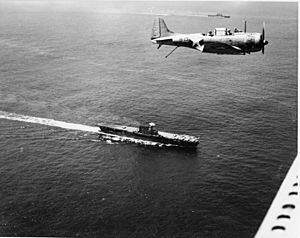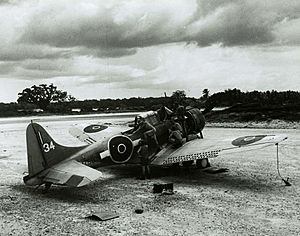Douglas SBD Dauntless facts for kids
Quick facts for kids SBD DauntlessA-24 Banshee |
|
|---|---|
 |
|
| A U.S. Navy SBD releasing a bomb. Note the extended dive brakes on the trailing edges. | |
| Role | Dive bomber Scout plane |
| National origin | United States |
| Manufacturer | Douglas Aircraft |
| Designer | Ed Heinemann |
| First flight | 1 May 1940 |
| Introduction | 1940 |
| Retired | 1959 (Mexico) |
| Primary users | United States Navy United States Marine Corps United States Army Air Forces Free French Air Force Royal New Zealand Air Force |
| Produced | 1940–1944 |
| Number built | 5,936 |
| Developed from | Northrop BT |
The SBD Dauntless was a famous dive bomber aircraft used by the United States Navy and United States Marine Corps during World War II. Its name, SBD, stands for Scout Bomber Douglas. It was built by the Douglas Aircraft Company, which is now part of Boeing. The Dauntless first flew in 1940 and quickly became an important plane. It was developed from an earlier plane called the Northrop BT.
This aircraft was designed to take off from aircraft carriers. Its main job was to attack enemy ships and submarines by diving straight down. The SBD-5, a later version, could fly at 255 miles per hour (410 kilometers per hour). It had a powerful 1,200 horsepower engine. The plane was armed with machine guns and could carry one bomb or torpedo. It could fly for over 1,100 miles (1,795 kilometers) and reach heights of 25,525 feet (7,780 meters). The Dauntless was retired from U.S. service in the late 1940s.
Contents
Designing the Dauntless: How it was Built
The design for the Dauntless started in 1935 with a plane called the Northrop BT-1. In 1937, Douglas Aircraft took over Northrop. The project continued under Douglas, led by a team of designers including Ed Heinemann. They improved the BT-1, creating the SBD.
The first SBD planes entered service in mid-1939. Both the U.S. Navy and Marine Corps ordered new versions, called the SBD-1 and SBD-2. The SBD-1 went to the Marine Corps in late 1940. The SBD-2 joined the Navy in early 1941. These planes replaced older models on U.S. carriers.
A special feature of the Dauntless was its "dive-brakes." These were perforated flaps that helped the plane slow down during its steep dives. This prevented the tail from shaking too much. Unlike many carrier planes, the Dauntless did not have folding wings. This design choice made the plane stronger.
Improved Versions of the SBD
The SBD-3 was the next major version, built starting in 1941. It had better armor and self-sealing fuel tanks. It also carried four machine guns. The SBD-4 came next, with an improved electrical system. Some SBD-4s were changed into reconnaissance planes for scouting.
The SBD-5 was the most common version. Over 2,400 of these were built. It had a more powerful 1,200 horsepower engine and carried more ammunition. A few SBD-5s were sent to the Royal Navy for testing. Besides the U.S., the SBD-5 was used by the Royal New Zealand Air Force and the Free French Air Force. Some were also sold to Mexico.
The final version was the SBD-6, which had even more improvements. Production of the Dauntless ended in the summer of 1944.
The A-24 Banshee: Army's Version
The U.S. Army Air Forces had its own version of the SBD, called the A-24 Banshee. This version did not have the arresting hook used for landing on aircraft carriers. It also had a different tail wheel. The Army used 948 of the 5,937 Dauntless planes built. There were three versions of the Banshee: A-24, A-24A, and A-24B.
The Dauntless in Action: Key Battles
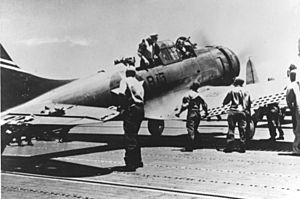
The SBD Dauntless first saw action at Pearl Harbor in December 1941. Many Marine Corps SBDs were destroyed on the ground during the attack. However, on December 10, 1941, SBDs from the aircraft carrier USS Enterprise successfully sank the Japanese submarine I-70.
In early 1942, SBDs from U.S. carriers attacked Japanese bases in various islands like the Gilbert Islands and Marshall Islands.
Battle of the Coral Sea
The first major battle for the SBD was the Battle of the Coral Sea in May 1942. SBDs, along with TBD Devastator torpedo planes, sank the Japanese light aircraft carrier Shōhō. They also damaged another Japanese carrier, Shōkaku. SBDs also helped protect U.S. carriers by shooting down Japanese planes.
The Dauntless had strong machine guns. It had two forward-firing .50 caliber guns and one or two rear-facing .30 caliber guns. These guns were effective against the lightly built Japanese fighter planes. Many SBD pilots and gunners bravely fought back against enemy fighters.
Battle of Midway: A Turning Point
The SBD's most important role was in the Battle of Midway in June 1942. This battle was a major turning point in the Pacific War. Four squadrons of Navy SBD dive bombers attacked and sank or badly damaged all four Japanese aircraft carriers present: Akagi, Kaga, Sōryū, and Hiryū. Three of these carriers were hit within just six minutes! The SBDs also heavily damaged two Japanese heavy cruisers.
The success at Midway was partly because American planes attacked at the same time from different directions. This confused the Japanese fighter planes, leaving the SBDs free to attack the carriers.
Guadalcanal Campaign
SBDs were also very important in the Guadalcanal Campaign. They operated from both U.S. carriers and from Henderson Field on Guadalcanal. They were very dangerous to Japanese ships trying to pass through the area during the day. During this campaign, SBDs sank a Japanese carrier, a cruiser, and nine transport ships.
Later War Efforts
In the Atlantic Ocean, SBDs took part in Operation Torch in North Africa in November 1942. Later, in October 1943, SBDs from the USS Ranger attacked German ships near Bodø, Norway.
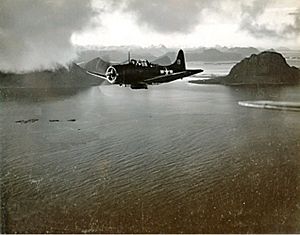
By 1944, the U.S. Navy began replacing the SBD with a newer, more powerful plane called the Curtiss SB2C Helldiver. However, many dive bomber pilots still preferred the SBD. It was lighter and easier to handle, especially for landing on carriers.
The Dauntless was one of the most important aircraft in the Pacific War. It sank more enemy ships in the Pacific than any other Allied bomber. It was even credited with shooting down more enemy planes than it lost to enemy action. This is very rare for a bomber!
A total of 5,936 SBDs were built during the war. The last one was made on July 21, 1944. By April 1944, SBDs had flown over 1.1 million hours in combat. Their amazing record shows they sank six Japanese aircraft carriers, 14 cruisers, six destroyers, 15 transport ships, and many smaller vessels.
United States Army Air Forces (A-24 Banshee)
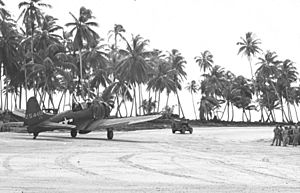
The U.S. Army Air Forces received 52 A-24 Banshees in late 1941. These were meant for the Philippines, but after the Attack on Pearl Harbor, they were sent to Australia. Many A-24s had mechanical problems.
The 91st Bombardment Squadron used A-24s to attack enemy targets around Java Island. However, they suffered heavy losses. After two A-24s were shot down and three badly damaged, the squadron had to leave Java.
Remaining A-24s in Australia were used to defend New Guinea. On July 26, 1942, seven A-24s attacked a convoy, but only one survived. Many pilots felt the A-24 was too slow and had too short a range. Because of this, most A-24s were used for non-combat missions, like training. Later, the more powerful A-24B was used in the Gilbert Islands from December 1943 to March 1944. After that, A-24Bs were also pulled from combat.
A few A-24s remained in service long enough to be taken over by the United States Air Force (USAF) when it became a separate branch in 1947. They were renamed F-24 Banshees and were used for training until 1950.
The first SBD-3 planes were actually ordered by the French Navy. However, when France fell in 1940, these planes were given to the U.S. Navy instead.
Later, in 1944, the Free French forces received about 80 SBD-5s and A-24Bs from the United States. They used these planes for training and for supporting ground troops. French Air Force squadrons used A-24Bs to support Allied forces in southern France. They also attacked German-occupied cities on the French Atlantic coast.
The French Navy's Dauntless planes were the last to see combat. They were used during the First Indochina War in the late 1940s. They flew from the aircraft carrier Arromanches. By 1949, the French Navy stopped using the Dauntless for combat, but it was still used for training until 1953.
Royal New Zealand Air Force
The Royal New Zealand Air Force received 18 SBD-3s and 23 SBD-4s. No. 25 Squadron RNZAF used them in combat in the South Pacific. However, the RNZAF soon replaced them with faster F4U Corsairs.
Different Types of Dauntless Planes (Variants)
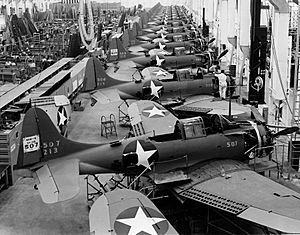
Over time, the SBD Dauntless was updated and improved. Here are the main versions:
- XBT-2: This was the very first prototype, a modified Northrop BT-1.
- SBD-1: This version was for the Marine Corps. It had no self-sealing fuel tanks. 57 were built.
- SBD-2: This Navy version had more fuel and different weapons. 87 were built.
- SBD-3: Built from 1941, it had better armor, self-sealing fuel tanks, and four machine guns. 584 were built.
- SBD-4: This version had an upgraded electrical system. 780 were built.
- SBD-5: The most common version, with a 1,200 horsepower engine and more ammunition. 2,965 were built.
- SBD-6: The final version, with a 1,350 horsepower engine. Production ended in 1944. 450 were built.
A-24 Banshee Versions
The A-24 Banshee was the Army's version of the SBD.
- A-24 Banshee (SBD-3A): The Army's version of the SBD-3, without the carrier hook. 168 were built.
- A-24A Banshee (SBD-4A): The Army's version of the SBD-4. 170 were built.
- A-24B Banshee (SBD-5A): The Army's version of the SBD-5. 615 were built.
Who Used the Dauntless? (Operators)
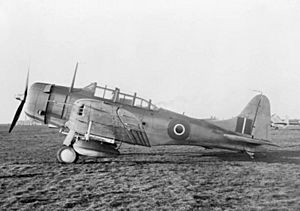
Several countries and military branches used the SBD Dauntless and A-24 Banshee:
 Chile Chilean Air Force
Chile Chilean Air Force France French Air Force and French Navy
France French Air Force and French Navy Mexico Mexican Air Force
Mexico Mexican Air Force Morocco Moroccan Desert Police
Morocco Moroccan Desert Police New Zealand Royal New Zealand Air Force (specifically No. 25 Squadron RNZAF)
New Zealand Royal New Zealand Air Force (specifically No. 25 Squadron RNZAF) United Kingdom Royal Air Force and Royal Navy Fleet Air Arm (for evaluation)
United Kingdom Royal Air Force and Royal Navy Fleet Air Arm (for evaluation) United States United States Army Air Forces, United States Marine Corps, and United States Navy
United States United States Army Air Forces, United States Marine Corps, and United States Navy
Where Can You See a Dauntless Today? (Surviving Aircraft)
Many SBD Dauntless and A-24 Banshee planes have survived and are on display in museums around the world. Some are even still able to fly!
New Zealand
- SBD-4 (06853) is at the Air Force Museum of New Zealand in Christchurch.
Solomon Islands
- An SBD (unknown number) is at the Vilu Military Museum in Guadalcanal.
United States
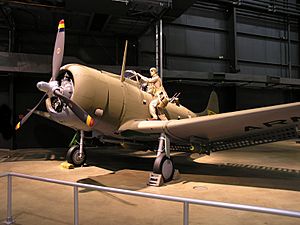
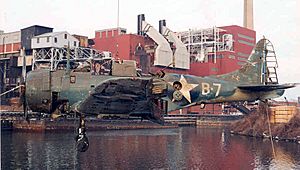
Still Flying
- A-24A (42-60817) flies from the Erickson Aircraft Collection in Madras, Oregon.
- A-24B (42-54682) flies from the Lone Star Flight Museum in Houston, Texas.
- SBD-4 (10518) flies from the Yanks Air Museum in Chino, California.
- SBD-5 (28536) flies from the Planes of Fame Air Museum in Chino, California.
- SBD-5 (54532) flies from the Commemorative Air Force – Dixie Wing in Peachtree City, Georgia.
On Display
- A-24B (42-54582) is at the National Museum of the United States Air Force in Dayton, Ohio.
- A-24B (42-54654) is at the Pima Air & Space Museum in Tucson, Arizona.
- SBD-2 (02106) is at the National Naval Aviation Museum in Naval Air Station Pensacola, Florida. This plane fought at Pearl Harbor attack and the Battle of Midway.
- SBD-2 (02173) is at the Pearl Harbor Aviation Museum at Ford Island, Hawaii.
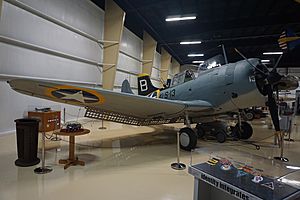
- SBD-3 (06508) is at The National WWII Museum in New Orleans, Louisiana.
- SBD-3 (06583) is at the National Museum of the Marine Corps in Marine Corps Base Quantico, Virginia.
- SBD-3 (06624) is at the Air Zoo in Kalamazoo, Michigan.
- SBD-3 (06694) is on the USS Lexington (CV-16) museum in Corpus Christi, Texas.
- SBD-4 (06833) is at the National Naval Aviation Museum in Naval Air Station Pensacola, Florida, shown as if recovered from underwater.
- SBD-4 (06900) is at the San Diego Aerospace Museum in San Diego, California.
- SBD-4 (10575) is at the Battle of Midway Memorial at Midway Airport in Chicago, Illinois.
- SBD-5 (36173) is on the USS Yorktown (CV-10) at the Patriots Point Naval and Maritime Museum in Mount Pleasant, South Carolina.
- SBD-5 (36176) is at the Palm Springs Air Museum in Palm Springs, California.
- SBD-6 (54605) is at the National Air and Space Museum in Washington, D.C..
- SBD-6 (54654) is at the USS Midway Museum in San Diego, California.
Being Restored or in Storage
- A-24B (42-54643) is in storage at Fantasy of Flight in Polk City, Florida.
- SBD-1 (01612) is being prepared for display at the Flying Leatherneck Aviation Museum in San Diego, California.
- SBD-4 (10508) is being prepared for display at the Castle Air Museum in Atwater, California.
- SBD-5 (36175) is being restored to fly at the Military Aviation Museum in Virginia Beach, Virginia.
Images for kids
-
Rear gunner position on A-24 displayed at the National Museum of the United States Air Force
See also
 In Spanish: Douglas SBD Dauntless para niños
In Spanish: Douglas SBD Dauntless para niños


